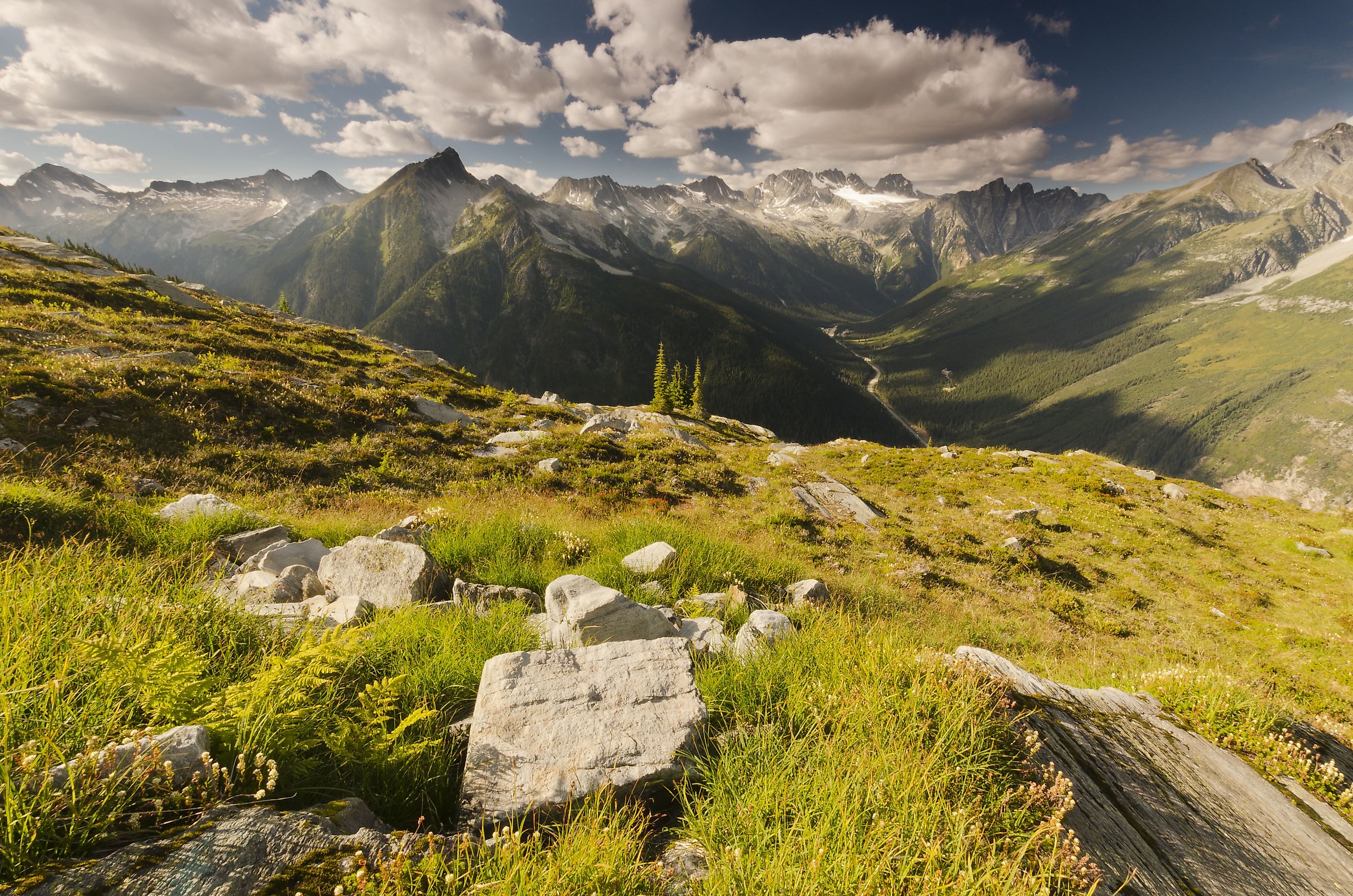
Experience Canada's Own Glacier National Park
To many, Glacier National Park is known as one of the most iconic American wildlands, located in the Rocky Mountains of western Montana. However, neighboring Canada has its own federally managed park of the same name, and an argument can be made that it is just as magnificent.
Glacier National Park in British Columbia is seated along the same mountain range as its southern counterpart and brings to the table many of the same attractions, including numerous hiking routes, campgrounds, lodges, ski resorts, and tons of opportunities to go wildlife-watching. Let's take a deeper look at this western Canadian national park and why it stands out as among the best in the country.
The Geography of Glacier National Park
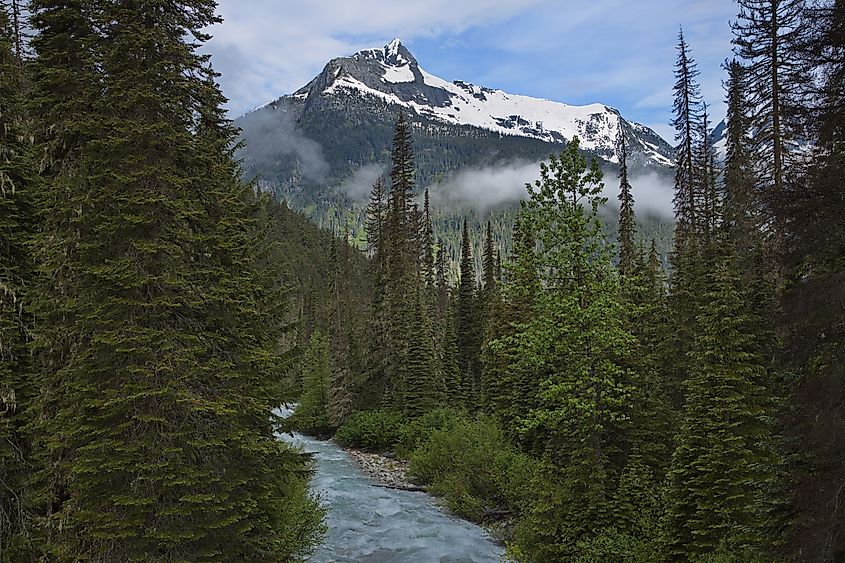
Morning at Illecillewaet River in Glacier National Park in British Columbia,Canada,North America.
Glacier National Park, located in southeastern British Columbia, covers 1,349 square kilometers within the Selkirk and Purcell mountain ranges, part of the western slope of Canada's Rocky Mountains. The park’s landscape is defined by its numerous steep peaks (many of which are named), glacial lakes, and the extensive icefields that give it its name. Its elevation ranges from approximately 1,000 meters in the valley floors to over 3,280 meters at the summit of Mount Sir Donald, one of its most iconic mountains.
Near the center of the park lies the Illecillewaet Icefield, a remnant of the vast glaciers that once covered much of the region during the last Ice Age. This icefield feeds several glaciers, including the Illecillewaet and Great Glacier, which were significant attractions during Canada’s late 19th-century alpine tourism boom. Rivers such as the Illecillewaet and Beaver originate within the park and contribute to the Columbia River watershed.
The park’s steep and rugged terrain results in a range of microclimates throughout, from temperate old-growth rainforest in the lower valleys to alpine tundra at higher elevations.
Wildlife
Glacier National Park straddles the boundary between interior and coastal ecosystems, supporting a diverse selection of plant and animal species. The park’s unique geography makes it a critical habitat for wildlife.
Fauna
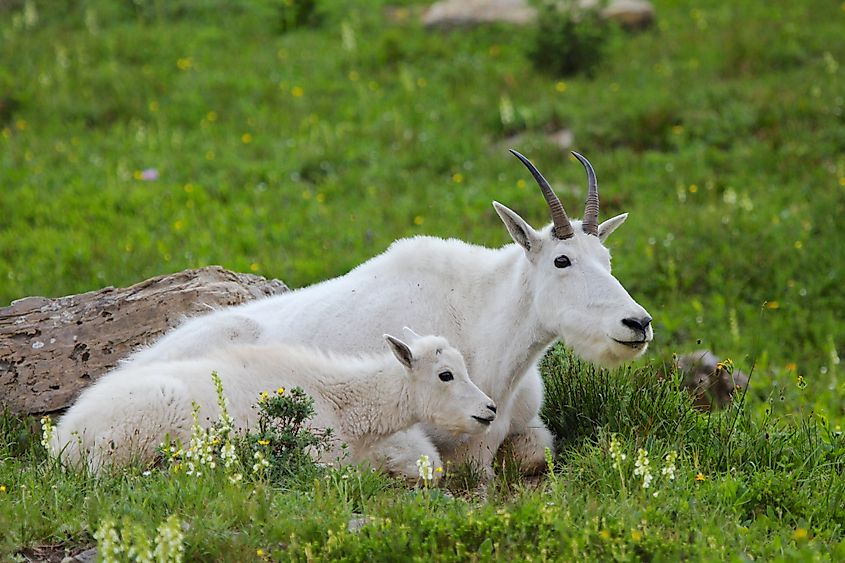
This expansive park is home to an array of wildlife, ranging from endangered to more common species. Large mammals such as grizzly and black bears, mountain goats, and elk roam its varying terrain, while the elusive mountain caribou finds refuge in the park’s old-growth forests. Predators like wolves and wolverines also inhabit the area.
In the skies, bird species include golden eagles, peregrine falcons, and diverse alpine songbirds, while the park’s waterways host a small selection of fish species, mainly lake trout at spots like Trout Lake and Kinbasket Lake.
Flora
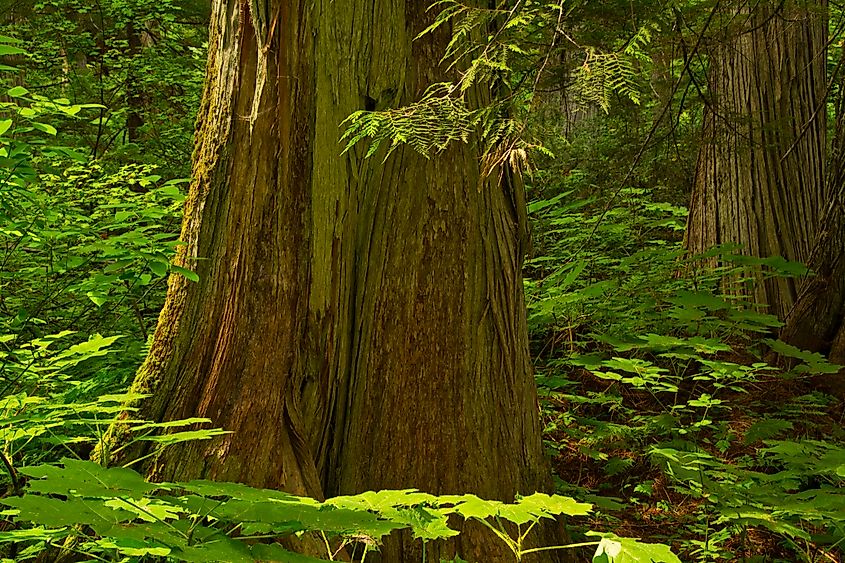
Old cedars, Hemlock Grove, Glacier National Park, British Columbia, Canada.
Just like with the park's animals, the widely varying altitudes here make way for a huge variety of plant life within its borders. Its lower valleys contain temperate rainforests with towering western red cedars and hemlocks, while mid-elevations are dominated by subalpine forests of Engelmann spruce and subalpine fir. Higher up, alpine meadows bloom with vibrant wildflowers such as glacier lilies and paintbrushes during the short summer. Mosses and lichens thrive in the moist environments of Glacier as well, blanketing rocks and forest floors.
What to do in Canada's Glacier National Park
This park in the heart of Canada's Rockies is rich in things to see and do. From sightseeing to high-adrenaline adventure, here are some of the best destinations to see and activities to take part in during your next visit.
Stop at the Rogers Pass Discovery Centre
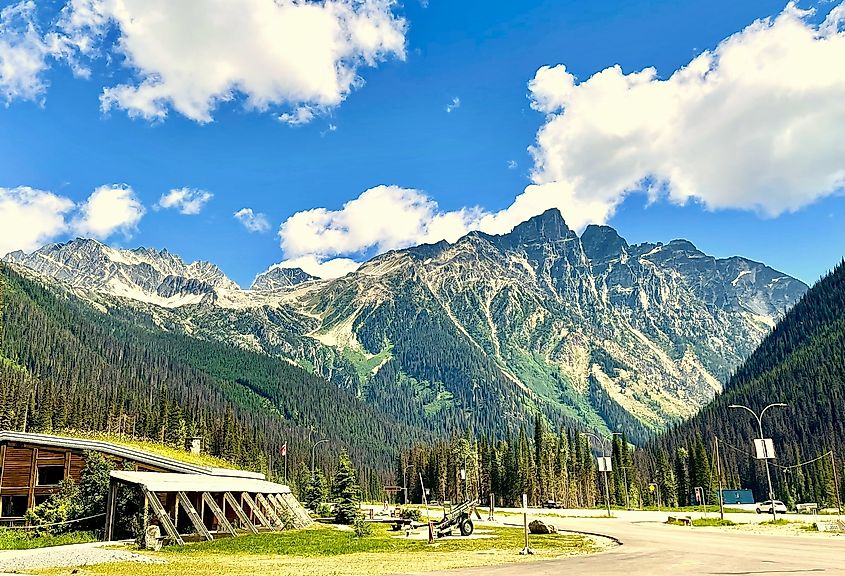
The Rogers Pass Discovery Center, located at the side of the Trans-Canada Highway that runs through the park, is a perfect place to start your visit. Featuring a museum, ticket booths, a gift shop, and amenities like rest areas and heated bathrooms, it is helpful in both teaching you a thing or two about Glacier National Park and giving travelers a convenient place to take a break.
The museum contains detailed displays about the park's wildlife, geography, and natural and human histories, while the well-stocked gift shop is the spot to pick up informative books, souvenirs to remember your trip, and hiking supplies like maps, water bottles, snacks, bear spray, and more.
Go For a Hike
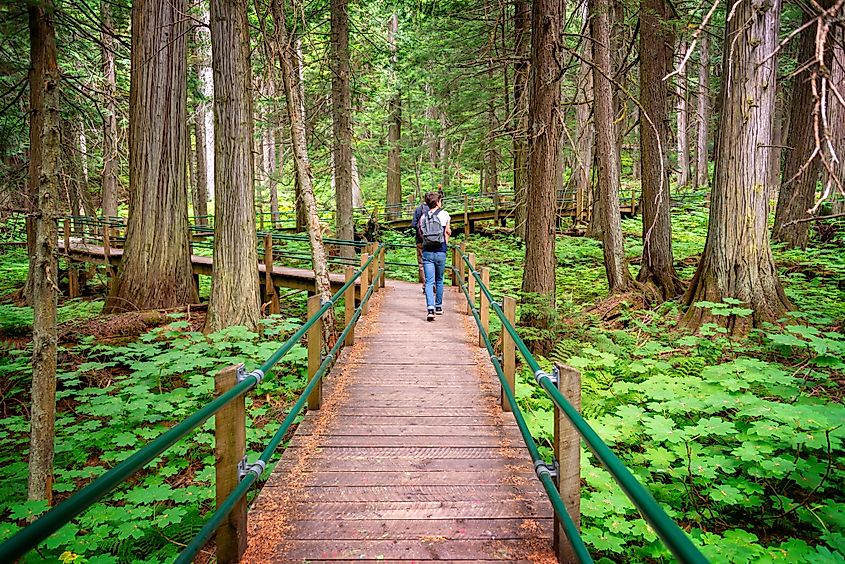
People visiting Hemlock Grove Boardwalk trail, Glacier National park, Rocky Mountains, Bristish Columbia, Canada.
Hiking is one of Glacier National Park's main draws. With over 140 kilometers of trails, hikers can choose from a huge selection of routes that suit their experience and fitness levels. The Bear Creek Falls Trail, for example, provides an easy option, leading to a picturesque waterfall. For a more challenging experience, the Abbott Ridge Trail ascends steep terrain, rewarding you with far-reaching views of the Illecillewaet Glacier and surrounding peaks.
The Great Glacier Trail, one of the park’s most iconic routes, will take you close to the remnants of the Great Glacier, a site that was a major draw for tourists in the early days of the park, but still wows visitors to this day and shows the effect of rising global temperatures. Along the way, interpretive signs highlight the area's glacial history and ecology.
While on the trail, wherever you may be, you should be prepared for rapidly changing weather and carry essential gear, as the park's mountainous terrain can be unpredictable. This means packing appropriate clothing, like rain shells in the summer and winter gear in the colder months. Wildlife encounters, including bears, are also common, so please practice keeping a safe distance from animals and carry a can of bear spray at all times.
Skiing and Snowboarding
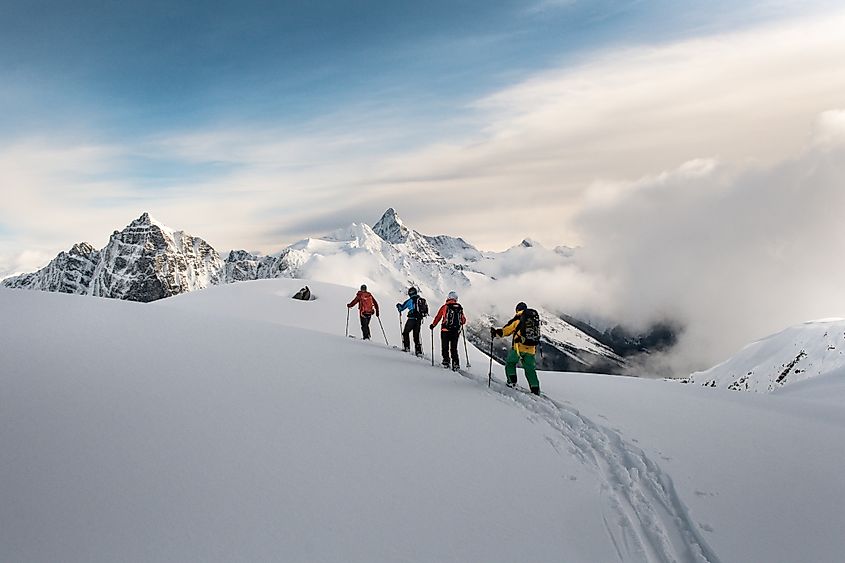
Skiers hiking in Glacier National Park in British Columbia climbing, views of mountains, powder, sky, track, skitouring with guide.
Within the confines of the park, backcountry skiing and snowboarding are hugely popular, while actual resorts near the park provide more modern and comfortable downhill experiences.
Renowned for its deep snowpack and challenging terrain, Glacier offers a wilderness experience far removed from crowded ski resorts. The Rogers Pass area, in particular, is a hub for winter sports, with its steep slopes, open glades, and access to expansive alpine bowls. Its trails draw snowshoers looking for a winter hike. The park also features designated winter camping areas, allowing multi-day trips for those seeking extended exploration.
Groomed ski hills nearby, like Kicking Horse Mountain Resort on the outskirts of the town of Golden and Revelstoke Mountain Resort in Revelstoke offer modern amenities on both sides of the parks, with their ski lifts and cozy lodges.
Where to Stay While Visiting the Park?
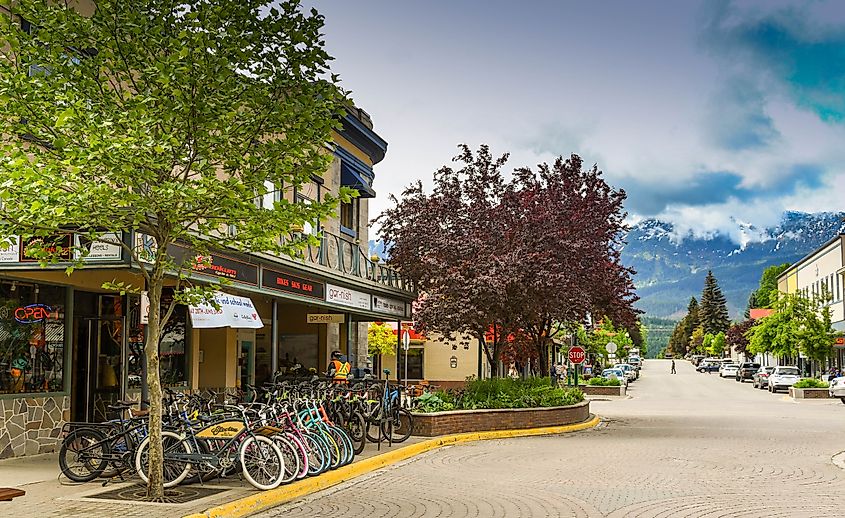
REVELSTOKE, BRITISH COLUMBIA, CANADA: Bicycles for hire lined up outside a shop in Revelstoke town centre. Editorial credit: Ceri Breeze / Shutterstock.com
Several towns near Glacier National Park in British Columbia provide convenient lodging and amenities for visitors. Revelstoke, located about 45 minutes west of the park, is usually the most popular choice, offering a range of accommodations, restaurants, and outdoor gear shops. Its wonderful downtown core and proximity to both the park and Revelstoke Mountain Resort make it ideal for adventurers of all kinds.
Golden, situated an hour east of the park, is another excellent base. Nestled in the Columbia Valley, it offers a quieter atmosphere closer to Alberta and access to additional outdoor activities, including those that can be found at other notable national parks like Yoho and Kootenay.
The Glacier House Resort near Rogers Pass is an iconic Canadian park lodge and also lies in close proximity to a number of local hiking trails and ski areas.
You may also enjoy a night at the Heather Mountain Lodge. Just outside the park’s northern boundaries, this one offers some of the most scenic and remote mountain views you can get from a hotel room.











